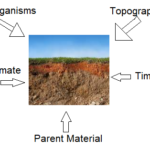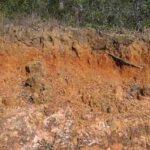The process of Soil formation, which is also known as pedogenesis, is a complex natural phenomenon. It is influenced by various factors such as climate, parent material, topography, organisms, and time. But here we will discuss pedogenesis in different climatic regions. In each region, climate plays a significant role in shaping soil characteristics, resulting in distinct soil types. Here’s a brief overview of how soil formation varies in different climatic regions:
Soil Formation in Arid Region
In “arid regions” where days are very hot and nights are cool, the rocks shatter mainly by the influence of unequal expansion and contraction. The soil, thus produced contains the grains of minerals, which are disintegrated from the original rock. The surface layers of such soils often become hard due to the crystallization of salts. The evaporation of water brings dissolved salts to the surface by capillary action, which cements the upper layer of the soil. The lime crust is found in the desert soils of Texas, New Mexico, and North Africa, while the gypsum crust occurs in Egypt and central Australian deserts.
Soil Formation in the Arctic Region
In “Arctic regions” the ice and frost actively take part in rock disintegration and produce a soil consisting of undecomposed mineral and rock particles. The soil mantle which is usually shallow, is characterized by abundant silt, peat, and water in a permanently frozen state.
Soil Formation in a humid temperate climate
In “humid temperate climate” the rocks are weathered predominantly by a combination of both disintegration and decomposition. Here “podzol” type of soil is formed. This soil shows the characteristic development of soil profile having A, B, and C horizons.
Soil Formation in Tropical Climate
In “tropical climate” chemical weathering plays an active role and rocks are weathered thoroughly up to a great depth. The most common soil in tropical areas is “laterite”, which develops as a result of weathering of silicate rocks. During weathering, most of the silica is leached out and the insoluble hydroxides of iron and alluminium accumulate near the surface to give rise to a reddish brown residual deposit. Laterite is a very useful construction material. When moist, it is soft and can be cut easily into bricks which become very hard on drying.
The soil of both temperate and tropical regions may develop a “hard pan” at some depth below the surface. The downwardly moving rainwater may bring leached silica from the upper horizons to the lower horizon, which it is redeposited. It causes the cementation of the soil layer. This type of hard, well-cemented, and impervious layer of soil is called “hard pan”. Such hard pans present a very useful horizon for the foundation of buildings and other structures.
Other posts you may like:


Leave a Reply